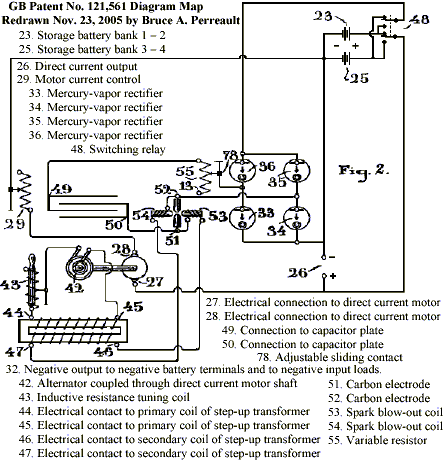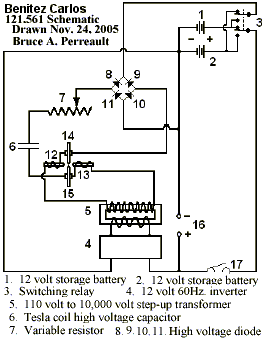# GB191417811, 1915-05-13, BENITEZ CARLOS F (MX), System for the Generation of Electric Currents
Abstract of GB191417811, by esp@cenet database:
17,811. Benitez, C. F. July 28. Distributing by condensers and transformers.- A transformer primary is connected between a condenser and earth by means of a rotary commutator, and the secondary is connected through an arrangement of condensers and transformers to the first condenser. One side of the condenser 1 is connected to a supply main 13 when the switch 14 is closed, and the other side is connected to the primary 3 of a transformer. The other terminal of primary 3 is connected alternately to earth and the condenser 1 through the brushes 38, 18 of the rotary commutator. On the secondary side 4 is an arrangement of condensers 5, 9 and transformers 7, 70. The circuits include rectifiers a …. f and a spark-gap 6. The commutator consists of three insulating – drums, each having a central conducting strip with two oppositely projecting longitudinal strips, those of the centre drum not being in line with the other two. The Specification states that when the switch 14 is closed and the commutator is in the position shown, the condenser 1 is charged and the primary 3 is energized, while on the secondary side a series of high-frequency currents are induced in the transformer 70, which charge the condenser 9 to a high potential. The system being self- working, the switch 14 may be opened. When the commutator is rotated through a quarter of a revolution, the condenser 1 discharges through the primary 3, and the charge on the condenser 9 is increased. The switch is then closed and the commutator rotated again. The condenser 1 is recharged from the condenser 9, and the currents may be employed to energize the transformer 10 and run the motor 12 to drive the commutator &c. The arrangement of transformers 50, 59 and con- denser 54 may be used in place of the high- frequency arrangement already described.
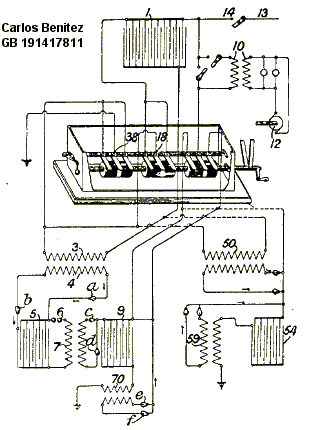
# GB191505591, 1915-08-19, BENITEZ CARLOS F (MX), System for the Generation of Electric Currents:
Abstract of GB191505591, by esp@cenet database:
5591. Benitez, C. F. April 14. [Addition to 17,811/14.] Supplying by arrangements of transformers and condensers.-In a modification of the system for generating electric cur- rents described in the parent Specification, vapour converters are dispensed with. In the arrangement shown, three pairs of condensers, 1, A, C and three transformers 2, 5, 25 are used, together with a commutator 38 for completing the circuits in the required order. The condensers 1 are first charged from an external source through the connector 13, which is then turned out of the vertical position so as to disconnect the condensers from the source. On moving the commutator into the position shown, the condensers are discharged through the primary of transformer 5, the secondary of which charges condensers A, C. On moving the commutator through a third of a revolution the condensers C are discharged through the primary of the trans- former 2, the secondary of which is connected to the inner coatings of the condensers A, the outer coatings of which are at this moment connected to the inner coatings of condensers 1. On moving the commutator again through a third of a revolution, the condensers A discharge through the primary of transformer 25, the secondary of which recharges condensers 1, the surplus energy being utilized through another transformer 30 for driving a motor 35 which turns the commutator and for other purposes. In a modification, the condensers A, C are permanently connected together and are charged, as before, from a condenser 1 through a transformer. The condensers A, C are then discharged through the primary of trans- former 25, the secondary of which recharges condenser 1 and furnishes surplus energy to a transformer 30.
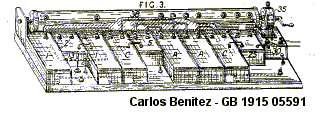
# GB191514311, 1916-08-17, BENITEZ CARLOS F (MX), System for the Generation of Electric Currents
Abstract of GB191514311, by esp@cenet database:
14,311. Benitez, C. F. Oct. 9. [Addition to 17,811/14.] Systems of charging and discharging galvanic batteries; supplying by arrangements of condensers and transformers; systems of charging and discharging condensers.-Batteries of accumulators are arranged in two sets, and one set, consisting of the parts 1, 2 being charged and arranged in series, is used to charge the second set consisting of the parts 3, 4 arranged in parallel or series-parallel. The charging-circuit contains the primaries 15, 27 of two transformers having condensers 14, 22 connected as shown, with a view to augmenting the charging-current, so that when the second set is fully charged by arranging its parts in series and the set 1, 2 in parallel, the second set will be used to charge the first, augmentation being again obtained. The effect obtained from the condensers and transformers is described in the parent Specification and in Specification 5591/15. A trembler may replace the spark-gap 23.
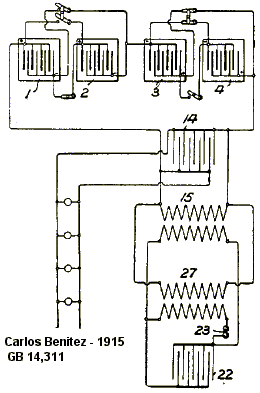
# GB Patent 121,561, Dec. 24, 1918, New Process for the Generation of Electrical Energy
Extracts from the patent:
I, Carlos Benitez, Civil Engineer, of 141, Ocampo Street, in Guadalajara, Mexico, do hereby declare the nature of this invention and in what manner the same is to be performed, to be particularly described and ascetained in and by the following statement:
This invention relates to a new utilisation of the high frequency currents or electrical oscillations, by means of which a constant production of electrical energy can be secured, under unusually simple, economic and practical conditions.
Such results are attained by means of the procedure disclosed in present applicant’s English Patent Specification No 14,311, filed on October 9th, 1915, but in order to obtain a better utilisation of said high frequency currents, and the automatic operation of the mechanisms employed in such procedure, I have invented a novel arrangement of parts, from which are derived several other advantages that will be hereinafter described and set forth with particularity in the claims appended hereto.
Synthetically, in such procedure so improved, are employed two batteries of accumulators, and one of these batteries is supposed that has been previously charged by proper means. Afterwards same said battery discharges through a circuit, in which are provided means for the utilisation of the greater part of the power produced by such discharge, and the remnant of same power is shunted from said circuit, into an oscillatory circuit in which the second battery is connected. Said oscillatory circuit is furthermore provided with a rectifier, which properly directs the electrical oscillations in such a manner, that they are forced to pass constantly through said second battery from the positive to the negative pole. On the other hand, as in such oscillatory circuits the number of oscillations per second can be varied at will, the current strength developped by these oscillations can be accordingly regulated, and thus the complete charge of the second battery can be produced in the same lapse of time in which the first battery discharges. Therefore it is only question of reversing the connections of said batteries from time to time and to repeat the same procedure, in order to obtain a continuous production of electrical energy.
The invention is illustrated in the annexed drawing in which:
Figure 1 shows the circuit connexions of the arrangement and a perspective view of a commutator;
Figure 2 is a lateral view of a part of same apparatus;
and Figure 3 and 4 are parts of same machine, whose location and use will be hereinafter explained
Same figures are employed to designate corresponding parts through the views.
In Figure 1 are depicted two batteries of accumulators 1-2 and 3-4 connected in series, but obviously any other connection can be used, and no matter what arrangement is employed, their positive poles 23, 25, are joined through the ammeters 22, 24, with the terminals 17, 20, of the commutator.
Such commutator consists of a cylinder 5, mounted on a rotative shaft 6, passing through two different supports 7 and 8, and same cylinder is provided with the conductive paths 9, 10, 11, 12, conveniently insulated and distributed on its surface. Furthermore same said cylinder is provided with the conductive paths 14 and 15, that can be better seen on the cross sectional view shewn by Figure 2. Said paths made of metallic strips bent in the arc of a circle, are fixed at one of the ends of same cylinder, and are arranged to make contact with the brushes 17, 18, 19, 20, properly insulated and fixed to a ring 16, which encircles the above mentioned cylinder 5, and is fastened to the same base of the apparatus.
Said brushes are provided with their corresponding sockets, onto which can be fitted plug connectors from the above described batteries and further apparatus as follows: terminal 17 is connected as above stated, with the positive pole 23 of battery 1-2; terminal 20 is connected through the ammeter 24, with the positive pole 25 of battery 3-4; terminal 18 is connected through the wire 26, with the terminal 27 of a direct current motor, whose terminal 28 is joined through the adjustable resistance 29 and the wire 30, with the terminal 31 of the commutator; and finally terminal 19 is connected through the wire 32, with the valves 33, 34, of an electrolytic rectifier, whose other two valves 35, 36, are connected by means of the conductor 37, with the terminal 38 of same commutator.
This apparatus is furthermore provided with the terminal 39, which is alternatively connected with the negative poles of each one of the above mentioned batteries, through the brushes that can be seen in the figure in contact with the cylinder 5. under these conditions the apparatus 40 and 41, which are employed to produce a practical purpose independent of the running of the ‘plant’, and which are connected to both terminals 31, 39, will be alternatively in circuit with the discharging battery, and thus part of the power produced by such discharge, will be utilised by said apparatus without impairing the normal running of the whole mechanism, as will be hereinafter explained.
On the other hand, an alternator 42, is coupled to the above mentioned motor 27-28, which in this manner can be rotated at a proper speed in order to attain the desired frequency. Both terminals of said alternator ae connected through the inductive resistance 43, with the poles 44, 45, of the primary of a step up transformer, whose secondary 46-47, duly connected to the condenser 48, will finally produce the high tension alternating current required for the charge of the said condenser. However the use of said motor and alternator, is not at all indispensable in this process, and the same results could be attained if the primary 44-45 of the transformer joined to an ordinary interrupter, be directly connected to the discharging battery.
The terminals 49, 50, of such condenser are connected through an arc-lamp of the Poulsen type 51-52, or through an adequated spark-gap with the above mentioned rectifier 33, 34, 35, 36, and hence with the battery that should be charged, which at the instant depicted by the figure is the battery 3-4.
Extending into the arc chamber are the poles of a strong electromagnet, the coils of which are in series with the arc, so that their exciting current is the arc current.
In this manner, the strong magnetic field which exists between the poles of the magnets acts on the arc, and owing to such action combined with the influence of the voltage developped by the secondary 46-47 of the transformer, it happens that said action and influence being about equal in value, are each of them alternatively greater than the other, so that the voltage across the arc automatically rises and fall. Therefore, when the action of the magnetic field is greater than the voltage produced by the secondary of the transformer, the current produced by said secondary has not enough pressure to pass across the arc and the condenser is charged, but an instant afterwards said action decreases in value, and the condenser discharges across same said arc. On the other hand owing to the oscillatory nature of the circuit, which is arranged with proper values of capacity, inductance, and resistance, said charges and discharges of the condenser can be obtained several millions of times per second if desired, and in this manner a current of a great number of amperes can be secured through the oscillating circuit, even with a small amount of electricity stored by said condenser. Just in the same manner as with a gallon of water could be produced a current of one thousand galons per second through a pipe, if such pipe be connected with two different vessels, and said quantity of water could be forced through such pipe, by means of a piston adapted to one of said vessels, so as to transfer same said quantity of water from to another vessel, one thousand times per second. Obviously what can be easily performed with electricity, is not so feasible with the water.
Speaking in other terms, the small amount of electric power taken by the direct current motor 27-28, appears with a small loss on the alternator 42, and such power is delivered to the primary 44-45 of the transformer. Again, the inductive action of this transformer produces on the secondary 46-47, a similar power still diminished in accordance with the efficiency of such apparatus, and finally the condenser is charged with a small amount of electricity in order to be converted into oscillatory energy. Obviously, if such electric power instead of being stored by said condenser had been simply rectified, and directly applied to the charge of one of the above mentionned batteries, such power would only produce a very small effect on this accumulators, and the whole discharge of the other battery would never cause the complete charge of the second group.
On the contrary, if the same said power is stored by said condenser 48, and this condenser is properly connected to an oscillatory circuit in which one of said batteries can be joined, and furthermore if by means of a rectifier the high frequency currents produced in such oscillatory circuit are forced to pass from the positive to the negative pole through said battery of accumulators, it is obvious to state that it is always possible to secure by these means, the number of amperes required by said accumulators in order to get them charged in a given time. That is to say, with a small number of coulombs stored by the condenser 48, it is possible to produce on the oscillatory circuit a great number of amperes, if same said number of coulombs are forced to pass and repass through said circuit, thousands or millions of times per second, just as was explained with the water analogy.
On the other hand, the valves of the above named quantities: capacity, resistance, inductance and voltage can be varied in very wide limits, and therefore it is always possible to attain the required conditions in each case, in order to produce a given number of oscillations per second: The capcity of the condenser can be adjusted to a certain value by increasing or diminishing the surface of its coatings. The resistance of the circuit can be adjusted to the required value varying the length of the arc in the Poulsen lamp, or varying the nimber of lamps connected in series or parallel in the circuit. The inductance of said circuit can be varied by winding part of same circuit on an insulating frame, in such a manner as to obtain the number of turns required to produce the desired inductance; and finally, the charging voltage can be regulated by increasing or diminishing the number of turns in the secondary of the transformer, or by varying the diameter of the wire employed in such coil.
Finally in order to obtain a better efficiency from the alternator 42, it is convenient to use the resonance coil or adjustable inductive resistance 43, in the circuit connecting said alternator with the primary 44-45 of the transformer. By so doing it is possible to adjust said resistance in order to obtain a state of resonance in the circuit, and in these conditions the current produced by said alternator will be in phase with the impressed E.M.F. ; therefore the effective watts will be a maximum in the primary and secondary circuits.
The adjustable resistance 29, which is disposed in the circuit connecting each battery of accumulators with the motor 27-28, is employed to adjust the current of the discharging battery to a fixed value, since it is important to obtain a constant number of revolutions from the alternator.
The commutator is furthemore provided with the voltmeters 56 and 57, and by means of the switches 58 and 59, the circuits connecting respectively both poles of each battery, can be closed through said meters, and the voltage of the discharging current may be so determined when desired. Finally, by means of the switch 60 connected acroos the terminals of the apparatus 40 and 41, such apparatus may be put on or out of operation at will.
With this arrangement, the initial charge of any of the above mentioned batteries, may be obtained by means of same motor 27-28, which in this case should be disconnected from the alternator 42, and coupled to any other motor, in order to be operated as a direct current generator. Such motor which is not illustrated in the drawing, may be a petrol or combustion engine of any kind, capable of an independent operation.
In such case, if it is desired to give a charge to any of the above batteries, the switch 60 should be closed, and next disconnecting the alternator 42, the direct current motor 27-28, should be coupled to the combustion engine, which once in operation will produce the running of said motor. This apparaatus acting now as a genarator will produce an electric current which passing through the terminal 27 will follow via: 26, terminals 18 and 17 of the commutator, (if it is the battery 1-2 which is going to be charged), wire 21, ammeter 22, pole 23, battery 1-2, path 9, switch 60, terminal 31, wire 30, resistance 29 and terminal 28….
In other words, each one of said batteries can be charged independently from the other, and one such result is attained, the combustion engine being already disconnected; if the plant should remain idle for some time, the cylinder 5 should again be turned until the brushes do not rest in touch with any of the above described conductive paths, and the whole arrangement will thus remain ready to be started at any instant.
… It is well known how the mechanical power developed by the rotary motion of the motor 27-28, can be turned into electrical energy by the alternator 42; and in the same manner it is well known how such electrical energy of low voltage can be transformed into one high voltage by means of a transformer; and it is well known too how such high voltage electrical energy can be converted into oscillatory energy, and how the alternating currents produced by such oscillations, can be rectified in order to produce a direct current. However all such combination of apparatus and means, arranged to produce the charge of a battery of accumulators while another similar battery is discharging, was perfectly unknown before this invention, and a short consideration of the calculations involved in determining the different values of capacity, resistance, inductance, and voltage required by the several combined circuits os a small working plant of this kind, may be useful to give an idea of the procedure which in general practice can be followed.
… It is obvious to state that the same procedure can be repeated indefinitely by the simple reversion of the connections of said batteries, from time to time, in accordance with the capacity of the accumulators employed, and the rate at which they are discharging.
In consequence, obtaining thus a continuous operation of such electric plant, its output can be easily determined, since from the power developed by the discharging battery, 400 watts only have been taken to produce the charge of the second group of accumulators, and the remnant of 2000 watts, that is to say a current of 40 amps x 50 volts is still available on the circuit in order to be utilised particularly by the apparatus 40 and 41. In fact the loss of power caused by the internal resistance of one of said batteries and of the circuit connecting such apparatus is of very small value, and may be determined as follows: …
… Summarily the production of electrical energy by such procedure, can not be less inexpensive, since the operation of a plant of this kind does not require a continuous provision of fuel, neither the installation of a water-power plant which is not always obtainable. By such procedure, the installation can be made just in the place in which the electrical energy should be employed, and once the installation is made, the plant can be kept in operation indefinitely at a trifling cost of maintenance.
… Obviously from the known accumulators the Edison type, being the most improved, is more suitable for such purpose. As it is well known in such type the active materials are oxides of nickel and iron, respectively for the positive and negative electrodes, the electrolyte being a 21 per cent solution of caustic potash in water, which should be removed once every 8 to 9 months, and the only care required with such cells, is to maintain the tops of the plates well covered with solution. Obviously as such solution is continuously evaporating, the cells must be frequently filled with pure distilled water, but such operation is easily performed by means of the automatic refiller that the Edison Company provides with this object.
… Having now particularly described and ascertained the nature of my said invention, and in what manner the same is to be performed, I declare that what I claim is:
In a Process for the Generation of Electrical Energy:
# 1 . Disposed in combination: One or more batteries of electric accumulators already charged, and connected to produce a predetermined voltage; said battery or batteries of accumulators disposed to discharge through a circuit in which are connected the required apparatus for the utilisation of the greater part of the energy produced by such discharge; same said circuit furthermore provided with appropriate apparatus arranged to take the remnant of said energy in order to be shunted into an oscillatory circuit; a second battery or batteries of accumulators connected to this oscillatory circuit, in order to be charged with the electric current developed by means of the oscillations obtained in such oscillatory circuit, while the first battery is discharging; a rectifier disposed in such oscillatory circuit in order to direct said oscillations in such a manner that they follow from the positive to the negative pole through said battery; said oscillatory circuit furthermore provided with capacity, inductance and resistance of proper values to allow the development of the required current strength, that will produce the complete charge of said battery while the other is discharging; and finally means for reversing the connections of both batteries from one to another circuit, in order to obtain a continuous production of electrical energy; all substantially as herein described and for the purposes set forth.
… # 5 . Disposed in combination, and for the purpose of connecting and reversing the operation of the two batteries of accumulators, which are employed in order to obtain a continuous production of electrical energy, the following: A commutator provided with several binding posts which may be connected to the corresponding poles of each one of said batteries; said posts provided with strips or brushes making a sliding contact with the surface of a cylinder mounted on a rotative shaft; said cylinder provided with properly insulated passages distributed on its surface, and arranged to connect the above mentionned strips, in such a manner that each one of said batteries can be alternatively connected to the discharging or the oscillatory circuit; two electro-magnets fixed to the same apparatus, and provided with movable iron cores attached to a lever mounted on the same shaft of said cylinder, and so disposed, that when said electro-magnets are energised, the cylinder is forced to revolve alternately in opposite directions; each one of the coils of said elecro-magnets respectively connected by one of their terminals, and through the minute and hour hand of an ordinary clock, to a source of electrical energy, and their other terminal directly connected to the remaining terminal of same said source; said clock provided with contacts conveniently insulated, and so disposed on its dial, that the circuit consisting of said magnets and source, can be closed through the minute and hour’s hand alternately through each one of said magnets.
Finally a handle fixed to the shaft of same cylinder commutator, in oreder to obtain its operation independently of the running of the plant; all substantially as herein described and for the purposes set forth. …
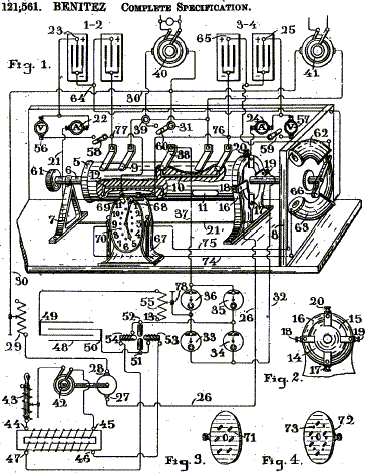
# and also Abstract of GB121561 by esp@cenet database:
121,561. Benitez, C. April 10, 1918. Systems of charging and discharging galvanic batteries. In an electric supply system comprising two sets of galvanic batteries, one set discharges to perform useful work and to charge the other set by means of an oscillatory circuit and a set of rectifiers.
The battery connections are varied by a commutator operated by solenoids, the circuits of which are controlled by a clock. In the position shown in Fig. 1 the commutator 5, mounted on a shaft 6, establishes the following discharging circuit for the battery 1-2-positive pole of battery, ammeter 22, lead 21, terminal 17, Figs. 1 and 2, segment 14, terminal 18, lead 26, motor 27, 28, lead 30, load 40, terminal 39, brushes and segment 9 of commutator 5, terminal 77 to negative pole of battery 1-2.
The motor 27, 28 drives an alternator 42 connected to the terminals 44, 45 of the primary winding of a transformer. The terminals 46, 47 of the secondary winding of the transformer are connected to a condenser 48 forming with an inductance 55 and an arc 51, 52 an oscillatory circuit, which operates as a source of energy to charge the battery 3-4 through rectifying valves 33, 34, 35, and 36 and the following circuit, lead 32, terminal 19, Figs. 1 and 2, segment 15, terminal 20, ammeter 24, battery 3-4, brushes and connection 10 of commutator, and lead 37.
After a pre-determined time, the commutator 5 is operated to place the battery 3-4 on discharge through the load 41 and motor 27, 28, and to place the battery 1-2 on charge from the oscillating circuit. The commutator 5 is operated by a handle or electro-magnetically by one of two solenoids 62, 63, the circuits of which are controlled by a clock 67. The minute hand of the clock is adapted to engage contacts 68, 69, and the hour hand is adapted to engage twelve studs 70. Six of the studs 70 are placed upon a metal disk 72, Fig. 4, provided with six holes through which the six other studs 70 on the disk 71, Fig. 3, pass. The disks 71 and 72 are connected respectively to solenoids 62, 63, Fig. 1, by leads 74, 75. In the position shown, the solenoid 62 is energized from one-half the battery 3-4; while one hour later the solenoid 63 is energized from one-half the battery 1-2 to change the position of the commutator.
Specification 14311/15, which describes a battery charging and discharging system, is referred to.
# 121,561 Redrawn by Bruce Perreault:
